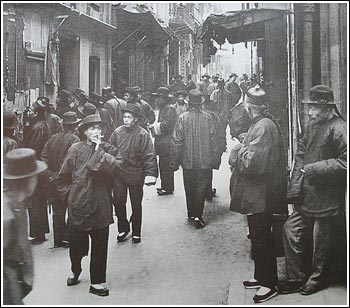
CRIMJ450W:
Lesson 1: Introduction to Race and Crime
Introduction
The purpose of this lesson is to provide the foundations for studying race and crime. First, the lesson defines the controversial terms race and ethnicity. The lesson also reviews the various sources of crime data and what they tell us about racial disparities in crime and victimization. Such disparities are not new, so we explore some of the earliest foundations of the issue. Finally, after realizing that all racial and ethnic groups in America have at some point been the focus of race and crime concerns, the lesson examines the similarities and differences between the experiences of the varying groups.
Objectives
By the end of the lesson, you should be able to:
- Define the concept of race and how it intersects with criminal justice;
- Review crime and victimization statistics by race;
- Examine the history of race and crime in America; and
- Appraise the common criminal justice-related experiences of American racial and ethnic groups.
Please complete readings and assignments as listed on the course schedule.
Video
Below are the lesson readings and video. Complete these before progressing to the author's commentary.
- Chapters 1 & 2 in Race and Crime (5th edition);
- Additionally, students will watch the video Scottsboro: an American tragedy. This video examines the notorious "Scottsboro Boys" trial. The case involved several Black youth who were accused of raping two White women on a train. The video highlights how race, class, and gender factored into one of the most well-known criminal justice cases of the 20th century.
Race and Ethnicity
Race is a term that is used to describe the classification of various groups across the globe by their origin, skin color, and customs. It used to be that it was accepted that race was a “social construct” or something social scientists made up simply to classify human beings. By and large, that is still the accepted notion. Interestingly, in the first U.S. Census conducted in 1790, there were only three categories: Free white males and females, All other free persons, and Slaves. Thus, the only acknowledged racial category was White. These categories have changed substantially over the last 200+ years. In recent years, these changes have been chronicled in an interactive website by the Pew Research Center. In contemporary America, the racial groups include Whites, Black/African American, Asian Americans, and Native Americans.
However, for some time now, there has been consensus that there are biological differences by race. For example, primarily Black people get the genetic disease Sickle Sell Anemia and largely Jewish people get Tay-Sachs disease. Also, some drugs seem to work better on Blacks than other groups. In past years, it has been found that some blood pressure medicine is better suited for Blacks than Whites. The central question that geneticists and more recently sociologists or criminologists and other social scientists have encountered is this: Are there substantive differences that make each race so unique that we can call them "distinct" races?; and, for theorists, the prime question is whether we can attribute maladaptive or deviant behavior to evolutionary differences in the make up of the various races? We will study all sides of this often cantankerous debate in the next lesson.

Ethnicity is typically used to refer to groups that do not fit one of the traditional racial categories but they are distinguished by their unique culture and history. During the height of massive immigration to the United States in the late 19th and early 20th centuries, it was not uncommon to see the use of terms such as Polish-American, Irish-American, Italian-American, etc. There has been the evolution of the use of these terms, with most White-ethnics being subsumed under the category of White. In the past few decades, the entire group of persons of descent from South America and the Caribbean have transitioned from being called Hispanic, Latino, to the gender-neutral term Latinx. In all cases, they are referred to as an ethnic group rather than a race. Why? Because somewhere along the line, it was noted that they can fall into the Black or White category, thus, they are not a distinct race. Hmmm...what do you think? While this is accepted in the scholarly community, some (including the author of the course!) have often wondered, can't this also apply to Blacks or Whites? As such, because Latinx are the largest minority in the United States, some believe they should be given "race status." In fact, there has been talk of categorizing Latinx as a race in the 2020 census. Thus, in line with this thinking, much of the discussion in this course treats them as a race. There is, however, a place for the term ethnicity. Both course texts note that there are ethnic groups subsumed within every major racial group. So, for example, someone I know is classified as a Black American - but he was born in England to Jamaican parents. Thus, his ethnic classification would be Jamaican. Or, what about the Latinx person who is of Cuban descent? Ethnicity is often not considered when we talk about race and crime. This is a serious problem since all ethnic groups subsumed within a particular racial category often don't face the same problems. Koreans, for example, might be facing different problems than Filipinos, etc. Consequently, the crime-related issues for each ethnic group might diverge as well.
Racial Disparities in Crime and Victimization
Before discussing the remaining contents of the lesson, I want each of you to do the following exercise. There are eight index offenses, which each of you should know by this stage of your academic career! Nonetheless, as a reminder, they are:
- homicide
- forcible rape
- aggravated assault
- robbery
- burglary
- auto-theft
- larceny-theft
- arson
Also, as recently noted, there are several major American racial and ethnic groups: Whites, Latinos, Blacks, Asian American and Native Americans. Since 2013, the Uniform Crime Reports (UCR) has included Latinos in their statistics. Prior to that time Latinos were subsumed under either the White or Black category. It has been noted that during this period, Latinos were mostly categorized as White. In the current UCR reports, the statistics are still categorized by race including the following categories: White, Black or African American, American Indian or Alaska Native, Asian, and Native Hawaiian or other Pacific Islander. Currently, the UCR provides figures that separate the arrest statistics by ethnicity using two categories: Hispanic and Latino or Not Hispanic or Latino. For this exercise, we are going to leave out the Hispanic/Latino and not Hispanic/Latino statistics. Your task is to complete the Race Matrix exercise below.
After you submit, read the text on the next page to give you more insight about your answers.
Race Matrix Instructions:
To complete the exercise, you need to record what percentage of index arrests YOU BELIEVE is attributable to each of the groups below (PLEASE DO NOT USE OUTSIDE SOURCES).
For example, Whites comprise what percentage of homicide arrests? How about Blacks? The percentages must total 100%. In other words, Whites can’t commit eighty percent of the homicides if you list blacks committing sixty percent.)
As you look at the actual percentages from this exercise, how close were your estimates? Also, how did you come to your conclusions on the percentages? If you’re like the hundreds of students who have taken my race and crime course over the past decade, the answer is typically the media, family, or conventional wisdom. In most instances, these will lead you down the wrong path. It might surprise some of you that Whites have committed most of the crime since the founding of America. Well, if you think about it, this fact makes sense since, except upon their arrival, when Native Americans comprised the largest population in North America, Whites have had the largest share of the US population.
As you can imagine, given the disparities across the various crime categories, the reason why people study race and crime is apparent. These disparities persist as you examine the crime victimization statistics presented in Chapter 2 of Race and Crime.
Racial Disparities in Crime and Victimization
As you look at the actual percentages from the previous exercise, how close were your estimates? Also, how did you come to your conclusions on the percentages? If you’re like the hundreds of students who have taken my race and crime course over the past decade, the answer is typically the media, family, or conventional wisdom. In most instances, these will lead you down the wrong path. It might surprise some of you that Whites have committed most of the crime since the founding of America. Well, if you think about it, this fact makes sense since, except upon their arrival, when Native Americans comprised the largest population in North America, Whites have had the largest share of the US population.
As you can imagine, given the disparities across the various crime categories, the reason why people study race and crime is apparent. These disparities persist as you examine the crime victimization statistics presented in Chapter 2 of Race and Crime.
Brief Historical Overview of Race and Crime in America
When most people think of questions related to race and crime, citizens often think of racial and ethnic minorities. One Gallup poll from the 1990s noted that half the respondents felt Blacks were prone to violence. The irony here is that most people don’t think in terms of the way race and crime has evolved in America. As pointed out in the Race and Crime text, over the last four hundred years, each racial and ethnic group has committed their share of crimes. From the genocide perpetrated against Native Americans, to the succession of White ethnic groups who successively viewed the next immigrant group as the crime problem. While the Race and Crime text clearly lays out the foundations of how race and crime has intersected in the lives of most groups that have been in America, there is a general pattern of how crime disparities materialize.

Step 1: An established racial and ethnic group takes notice of large numbers of immigrants moving to their areas.
Step 2: The new immigrant group is despised by the dominant group and is stereotyped using negative terms that label the immigrant group deviant.
Step 3: The new immigrant group struggles to survive and is often forced to engage in various criminal activities that typically culminate in organized crime and or gang formation.
Step 4: After a generation of struggle, the formerly new immigrant group assimilates to American life, and moves away from criminal activity and into more traditional ways of life.
Step 5: The next immigrant group moves in and the process begins all over again

There are clear exceptions to this process.
First, Native Americans were already here when Whites came and colonized them. Thus, given their unique cultural traditions, it was extremely hard for them to fully assimilate.
Second, unlike White immigrants who came here looking for opportunities, Africans were brought to America forcibly.
In addition, even after they were emancipated two centuries after becoming the primary labor force in the South, their search for prosperity was hampered by racism. It has been well-established that, over time, skin color prevented them from assimilating into the mainstream of American life. For Asian American, they also followed the same steps, but after being restricted to Chinatowns, they forged their success through a heavy emphasis on education.

Lesson Activity
There is one discussion forum for this lesson. After you have posted your general thoughts on the video, don't forget to read and respond to at least one posting from a classmate.
Summary
This lesson provided the foundation of race and crime.
First, we learned the difference between race and ethnicity.
Next we discussed the racial and ethnic disparities related to crime and victimization.
Here, we learned that while racial and ethnic minorities might be overrepresented in the index offenses, Whites remain the ones arrested for the most crime in the United States. Victimization data also showed disparities as to who gets victimized in America. The lesson also contextualized current racial disparities by noting the long history of races being differentially involved in criminal activity. All racial and ethnic groups have been considered "the crime problem." However, after a period of time, White ethnic groups have been able to fully assimilate and move away from being the problem. Some groups, such as Blacks, can never fully assimilate, and have remained "the crime problem." Today, scholars have sought to explain some of the prevailing racial disparities in crime and justice by drawing on criminological theory. In the next lesson, we review theories with religious and biological foundations.